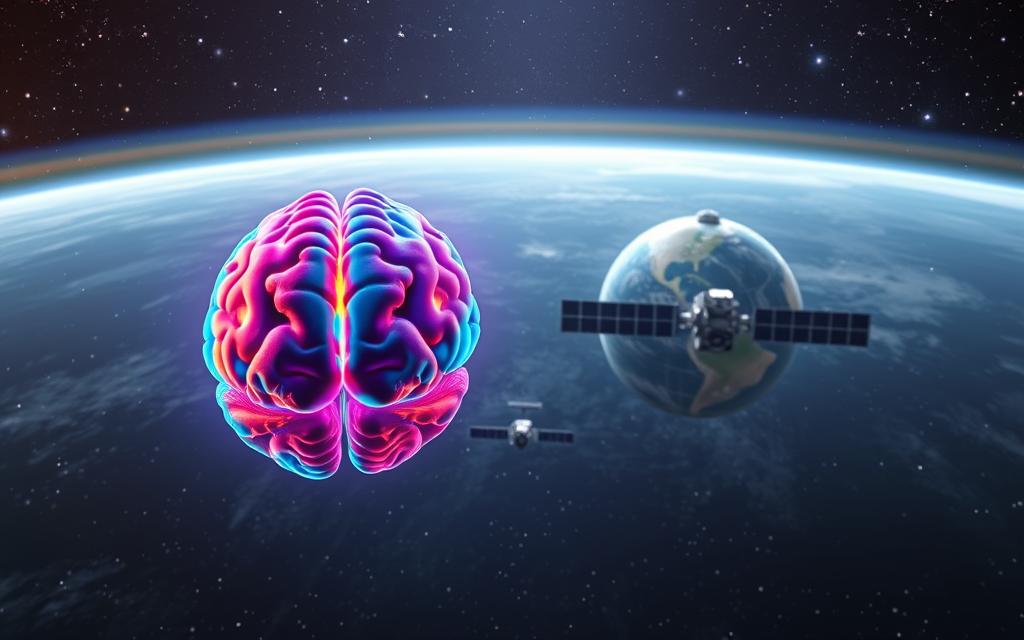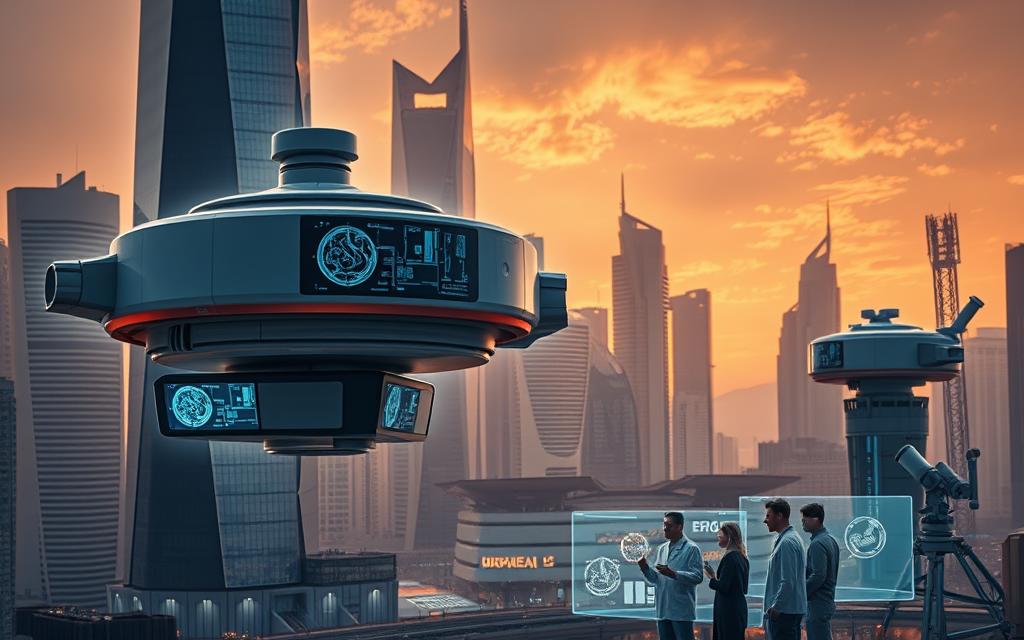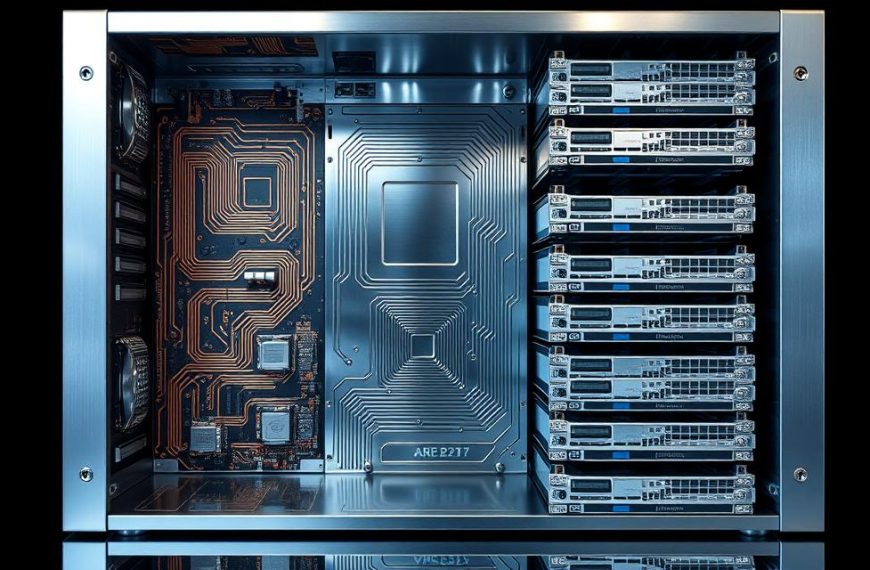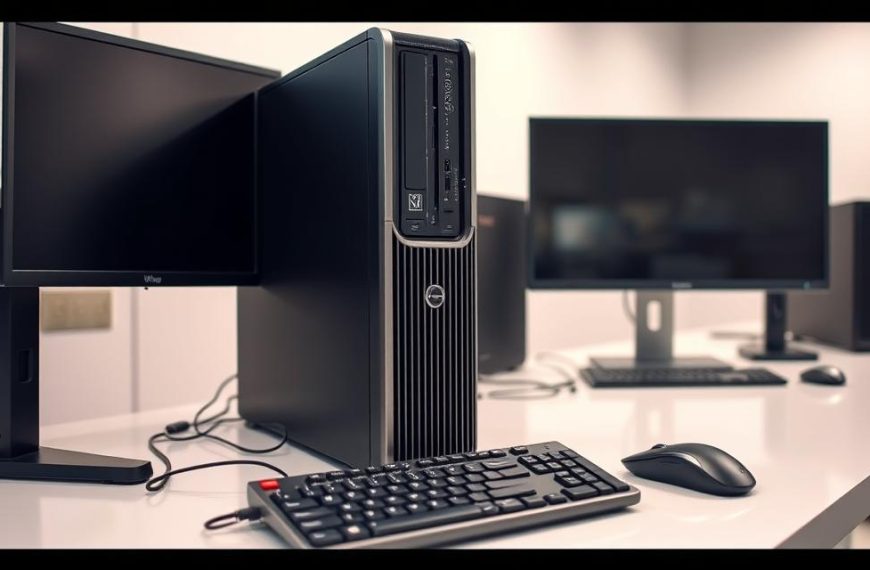Imaging technology allows precise visualisation of complex systems. It bridges the gap between medical diagnostics and space exploration. These sophisticated technologies have revolutionised our understanding of human physiology and celestial environments1.
Medical imaging has transformed healthcare with non-invasive methods to examine internal body structures. NASA’s research has contributed to developing advanced medical devices. These include sophisticated imaging systems that enhance diagnostic capabilities1.
Space exploration has also benefited from cutting-edge imaging technologies. Researchers use advanced imaging to monitor astronaut health and explore cosmic phenomena2. The main imaging method on the International Space Station uses ultrasound technology2.
Digital image processing tech, originally for lunar imaging, has enhanced medical diagnostic tools. This includes MRI and CT scans1. These advancements show the powerful link between medical research and space exploration.
Imaging technology continues to push scientific boundaries. It helps researchers visualise complex systems with incredible precision. These technologies represent the pinnacle of human scientific innovation.
What is Imaging Technology?
Imaging technology revolutionises how we see internal structures across various fields. It captures detailed images of objects or biological systems using advanced methods. From medical diagnostics to space exploration, these systems reveal what’s beyond visible surfaces3.
Medical imaging allows non-invasive diagnosis of injuries and diseases3. In 2010, about 5 billion medical imaging studies were done worldwide4. This shows how widely used these vital technologies are.
Fundamentals of Modern Imaging Systems
Modern imaging systems use diverse technologies to capture internal details. Key technologies include:
- X-ray imaging: Utilising radiation to visualise bone and tissue structures
- CT scans: Providing comprehensive cross-sectional views of internal organs
- Ultrasound: Using sound waves for real-time organ imaging
- Space-based telescopes: Capturing distant celestial objects
Types of Imaging Technologies in Use Today
Different imaging technologies offer unique capabilities. X-rays and CT scans use ionising radiation3. Ultrasound is one of the safest imaging methods3.
In medical settings, these technologies can spot tumours as small as 1.5-2.0 cm across5.
Evolution of Imaging Technology
The field has advanced rapidly through tech innovations. Artificial intelligence now enhances image interpretation, improving diagnostic accuracy3.
PET-CT and advanced MRI systems continue to expand what we can visualise4. Imaging technology blends scientific innovation with human curiosity.
From detecting tiny changes to exploring far-off galaxies, this tech opens new worlds. It’s a powerful tool that keeps evolving, offering exciting possibilities.
Medical Imaging Breakthroughs and Applications
Medical imaging has transformed diagnostic capabilities through remarkable technological advancements. CT scanning and X-ray technology have revolutionised how doctors visualise internal body structures. These tools enable precise medical diagnostics6.
The landscape of medical imaging continues to evolve with cutting-edge innovations. Key developments include:
- Integration of artificial intelligence (AI) in diagnostic processes7
- Advanced imaging modalities with reduced radiation exposure6
- Enhanced three-dimensional imaging techniques6
Modern medical imaging technologies are pushing boundaries in diagnostic precision. AI-powered analysis tools can reduce diagnosis time by up to 30%. This improvement dramatically enhances patient care7.
The AI segment in medical imaging is growing rapidly. It’s projected to expand from £762 million in 2022 to £14.4 billion by 20327.
| Imaging Modality | Key Characteristics |
|---|---|
| Magnetic Resonance Imaging (MRI) | High-resolution soft tissue visualisation without ionising radiation6 |
| Positron Emission Tomography (PET) | Molecular-level imaging crucial for cardiology and oncology6 |
| Hybrid Imaging | Integrates anatomical and functional data for enhanced diagnostics6 |
Researchers are exploring innovative approaches in medical imaging. These include 3D printing of organs from medical scans. They’re also developing more sensitive imaging technologies6.
These advancements promise more personalised and precise medical interventions. They also aim to make procedures less invasive for patients.
Space Exploration and Imaging Innovation
Space exploration has evolved through advanced imaging technologies. Researchers can now study celestial phenomena with incredible precision. These tools offer deep insights into the cosmos.
Neutron Star Interior Composition Explorer (NICER)
NICER revolutionises X-ray astronomy, allowing detailed study of neutron stars8. It examines high-energy radiation from extreme astronomical environments. This mission uncovers cosmic mysteries previously hidden from view.
- Investigates neutron star structures
- Utilises advanced X-ray detection technologies
- Provides insights into stellar evolution
X-ray Technologies in Space Research
Satellite imaging systems have transformed our understanding of space. Modern X-ray tech captures intricate details of distant celestial objects. These images reveal complex interactions between matter and energy9.
Satellite Imaging Systems and Quality Control
Space imaging sensors now capture expansive views with remarkable resolution9. A decade ago, these sensors averaged 16 megapixels. Today, they can reach up to 91 megapixels9.
- Enhanced pixel density
- Improved radiation resistance
- More efficient power consumption
Photonic integrated circuits are advancing satellite imaging technology. These innovations create more compact and powerful imaging systems. They promise to unlock even more cosmic secrets8.
Cross-pollination Between Space and Medical Imaging
Space exploration and medical imaging have transformed each other through technology transfer. This exchange has led to remarkable medical innovations. Patients worldwide now benefit from these space-derived advancements.

- Miniaturised X-ray technologies developed for space missions
- Advanced imaging sensors originally designed for satellite observations
- Compact diagnostic equipment inspired by spacecraft engineering
The Infrared Astronomical Satellite, launched in 1983, showcased space technology’s impact on imaging. Medical imaging has adopted similar principles, resulting in more precise diagnostic tools.
The synergy between space research and medical technology continues to push the boundaries of human understanding.
Specific technological crossovers include:
| Space Origin | Medical Application |
|---|---|
| Infrared Detection Systems | Advanced Cancer Screening |
| Radiation-Resistant Sensors | High-Precision Imaging Equipment |
| Miniaturised Electronics | Portable Diagnostic Devices |
Space agencies and medical researchers work together to drive innovation in imaging technologies. Their shared knowledge and resources create cutting-edge solutions for space exploration and healthcare.
This collaboration ensures a constant flow of new ideas and improvements. Both fields continue to grow and evolve, thanks to this fruitful partnership1011.
Future Prospects in Imaging Technology
Imaging technology is undergoing a revolutionary transformation. AI, quantum imaging, and telemedicine are driving this change12. AI is enhancing diagnostic capabilities, allowing for faster and more precise image analysis12.
New technologies are expanding medical diagnostic boundaries. AI systems can interpret scans with remarkable accuracy, often outpacing human radiologists12. Quantum imaging techniques promise more detailed and precise medical visualisations.
These innovations offer comprehensive structural insights and enable early disease detection. Portable devices are making healthcare more accessible than ever before.
- Advanced 3D and 4D imaging technologies provide comprehensive structural insights
- Molecular imaging enables early disease detection
- Portable diagnostic devices enhance healthcare accessibility
Telemedicine is expanding medical imaging’s reach. Handheld ultrasounds and point-of-care tech are transforming remote diagnostics12. These innovations are not just technological marvels but critical tools in democratising healthcare access.
The future of imaging technology lies in its ability to provide faster, more accurate, and more accessible diagnostic solutions.
Healthcare professionals worldwide are embracing these technological shifts13. Challenges remain in technology integration and workforce training. However, the potential for improving patient outcomes is vast1213.
Conclusion
Imaging technology has transformed our understanding of human biology and space. Since X-rays in 1895, we’ve seen remarkable progress to today’s AI-powered diagnostic tools1415. This journey of innovation has been truly extraordinary.
The fusion of medical and space imaging technologies showcases the power of cross-disciplinary research. Advanced imaging techniques have bridged these fields, offering unparalleled insights into health and cosmic exploration14.
AI-enhanced tools and sophisticated scanning technologies continue to expand our observational capabilities. These developments push the boundaries of our understanding in both fields.
Imaging technology leads the charge in scientific discovery. The ongoing collaboration between medical research and space exploration promises exciting breakthroughs. Researchers remain dedicated to expanding our capabilities in these areas.
This synergy ensures imaging technology will continue unravelling mysteries of human biology and the universe. The future holds great promise for further advancements in this critical scientific tool.
FAQ
What is imaging technology?
How do medical imaging technologies work?
What is the Neutron Star Interior Composition Explorer (NICER)?
How are space exploration technologies influencing medical imaging?
What role does artificial intelligence play in imaging technology?
What are the emerging trends in imaging technology?
How has imaging technology evolved over time?
What are the key applications of space-based imaging technologies?
How do imaging technologies contribute to medical diagnostics?
What future developments are expected in imaging technology?
Source Links
- https://science.howstuffworks.com/innovation/nasa-inventions/nasa-breakthroughs-in-medicine.htm
- https://pmc.ncbi.nlm.nih.gov/articles/PMC10395101/
- https://www.techtarget.com/whatis/definition/medical-imaging
- https://en.wikipedia.org/wiki/Medical_imaging
- https://pmc.ncbi.nlm.nih.gov/articles/PMC9192206/
- https://bmcmethods.biomedcentral.com/articles/10.1186/s44330-024-00010-7
- https://about.cmrad.com/articles/medical-imaging-research-2024-breakthroughs-in-ai-and-advanced-technologies
- https://www.nasa.gov/technology/
- https://www.techbriefs.com/component/content/article/28508-space-imaging
- https://www.frontiersin.org/journals/artificial-intelligence/articles/10.3389/frai.2024.1400732/full
- https://spinoff.nasa.gov/Spinoff2009/ip_3.html
- https://lakezurichopenmri.com/future-of-diagnostic-imaging/
- https://www.isrrt.org/wp-content/uploads/2023/07/the_global_future_of_imaging_a4_24pp-hr.compressed.pdf
- https://www.spectral-ai.com/blog/medical-imaging-technology-revolutionizing-diagnostics-and-treatment/
- https://www.ahu.edu/blog/imaging-technology













